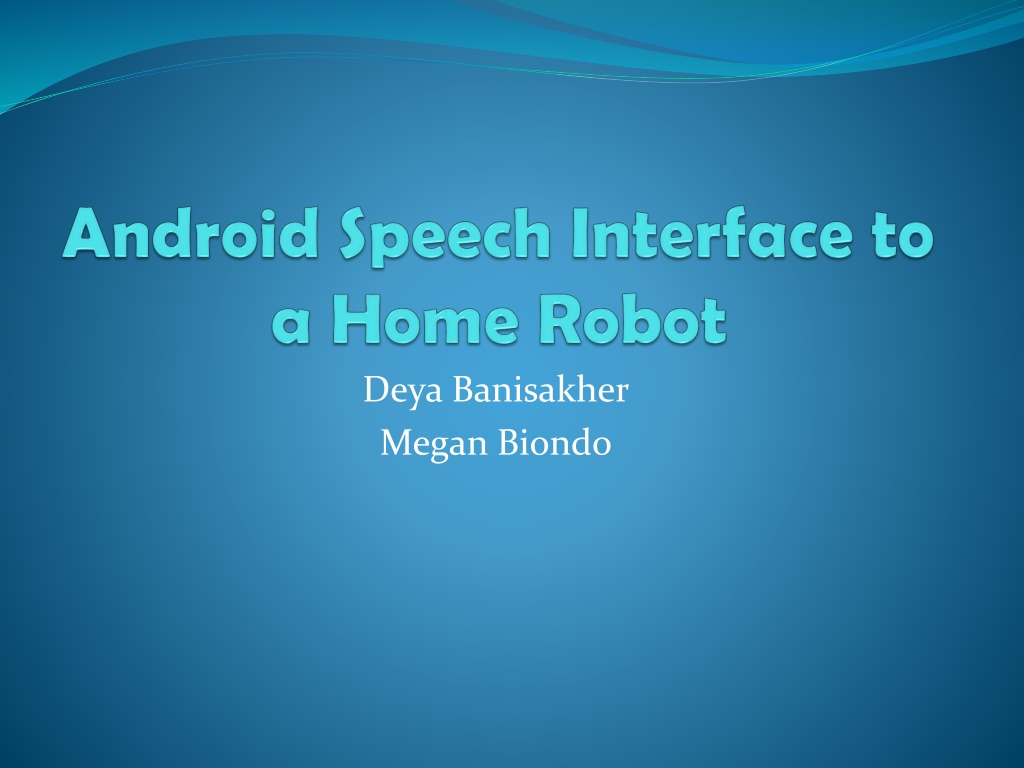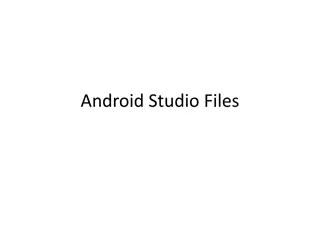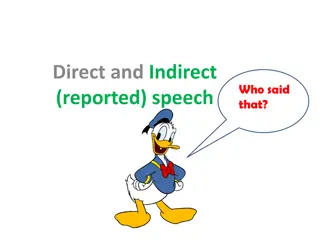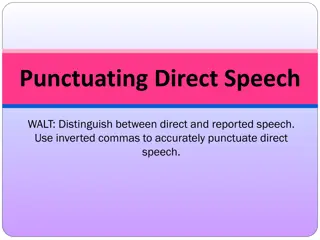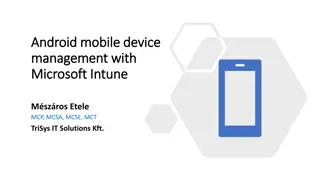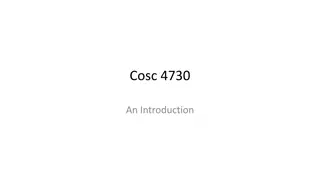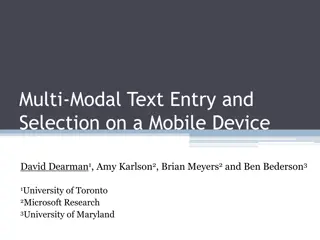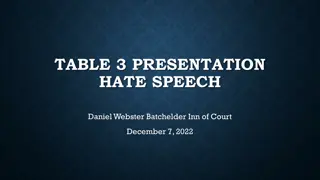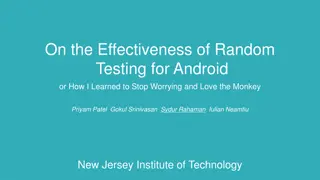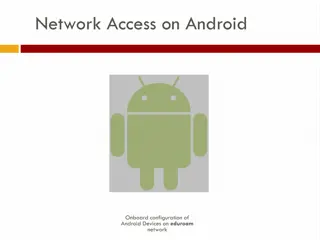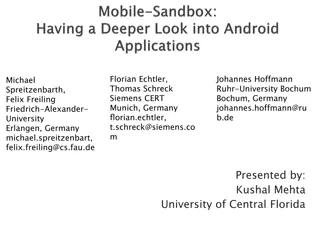Investigating Speech-to-Text Tools for Android Devices
Research group in Summer 2012 explored speech-to-text tools for Android devices, testing accuracy and developing an interface to transmit text to a mobile robot. The aim was to facilitate communication with assistive robots for tasks like fetching objects, aligning with seniors' preferences. The project involved investigating the use of speech recognition on Android phones and integrating it with a communication system. Previous work in spatial language studies and robot capabilities informed the research. Utilizing Android devices was preferred for their high accuracy and widespread availability.
Download Presentation

Please find below an Image/Link to download the presentation.
The content on the website is provided AS IS for your information and personal use only. It may not be sold, licensed, or shared on other websites without obtaining consent from the author.If you encounter any issues during the download, it is possible that the publisher has removed the file from their server.
You are allowed to download the files provided on this website for personal or commercial use, subject to the condition that they are used lawfully. All files are the property of their respective owners.
The content on the website is provided AS IS for your information and personal use only. It may not be sold, licensed, or shared on other websites without obtaining consent from the author.
E N D
Presentation Transcript
Deya Banisakher Megan Biondo
Research group (Summer 2012) Faculty Mentor: Prof. Marjorie Skubic Graduate Mentor: Ms. Tatiana Alexenko Undergraduate Student Researchers: Megan Biondo Deya Banisakher
Overview The Group will investigate speech to text tools available for the Android smart phone, test their accuracy, and develop an interface that transmits the recognized text to a mobile robot via wireless networking. If time permits, the students will test the speech interface for sending the robot spatial referencing commands, such as look for the hat on the table behind the couch .
Why it matters? Recent studies have shown that one of the top five tasks noted by seniors for assistive robots is help with fetching objects, for example, retrieving missing eyeglasses (Beer et al., 2012), and the preferred form of communication with the robot is a speech interface (Scopelliti et al., 2005).
What We Did We investigated the use of the built-in speech recognition in Android phones for use in this scenario. We created an Android application and implemented the underlying network and process communication system to support its use. We collected voice recognition transcriptions from old and young people; they spoke into an android device that had a testing application installed which we have developed. We also compared the accuracy of speech recognition on the Android phone for older and younger adults, as well as male and female ones. Integrated a server into ROS for communication with the Android device
Previous Work Skubic et al. have studied spatial language in older and younger populations. In collaboration with Carlson et al. at Notre Dame Dept. of Psychology, they collected speech samples of older and younger adults giving spatial descriptions (Carlson et al, in review). They also created a robot capable of recognizing furniture and processing textual spatial descriptions, in addition to the common robot capabilities such as obstacle avoidance. The robot was made to listen to commands coming from the user through a computer s keyboard that is wired to the robot itself.
Why Android? Known for high accuracy Freely available in Android-based devices which are being activated at a rate of 1 million devices perday worldwide (Android, 2012). It relies on crowd-sourcing in addition to integration of existing acoustic models. The useof Android devices for this purpose also has technical benefits: Theaudio processing and transcription is handled by Google s servers. Android application is easy to install on any Android device. Android devices and the operating systems support a wide range of accessibility features for helping the elderly use the different applications installed. Android devices have built-in microphones, eliminating the need for the user to purchasea headsetorother microphone. A speech recognition application allows the user to decide when they want to communicate with the robot, which prevents the robot from reacting to speech directed tootherpeople.
Why Android? (Cont) It utilizes Java s API into its development. Android makes it easy and practical for developers to change, switch and supply more resources to their applications by dealing with the XML based resources. XML is a simple language that Android allows developers to use to create and reference to sophisticated screen layouts and other resources such as pictures and videos. Android s platform and its use of Java s packages such as java.net, allows developers to use the phones hardware in a matter that is no different than a one in a fully featured computer.
System Components Server Client User Internet (Google) Wireless Router Figure 1. View of overall system communication.
What is ROS? ROS is an open-source, meta-operating system for robots. It provides the services you would expect from an operating system, including hardware abstraction, low-level device control, implementation of commonly-used functionality, message- passing between processes, and package management. It also provides tools and libraries for obtaining, building, writing, and running code across multiple computers. The robot uses ROS (Robot Operating System) which is based around publish-subscribe pattern. The server process inside of ROS publishes the textual transcriptions it receives from the Android device while other processes in the robot (primarily language processing) subscribe to the server s feed .
What is Inside the Server? Server Side (The Robot) ROS TCP Server Robot Node Publish Message Process Data/ Create Message Move According to Message/ Sensors Topic Data In (from device) SubscribetoTopic Figure 2. Server communication within ROS .
Application Overview (b) (d) (e) (a) (c) Figure 2. (a) User connects to robot. (b) User chooses to speak into phone. (c) User speaks into phone. (d) Phone displays the possible transcriptions to user. (e) Phone prompts user to send transcription selected to the robot.
Results We tested the accuracy of Android speech recognition for older and younger adults. Accuracy is one way to measure effectiveness of Speech-to-Text. It is calculated by taking the number of correctly transcribed words and dividing by the total number of words spoken. First, recordings were tested. Result: VERY BAD Then live voices were tested. Result: EXCELENT(Relatively!)
Speech Testing Results Original Data From recordings (0 out of 16 perfect) Transcription Accuracy of Older Voices (%) Avg Male (8) 27.49 Female (8) 44.00 Overall 35.74 Std. Dev. 24.78 34.39 30.18 Min. Max. 0 82.5 91.73 91.37 2.06 0 Even with recordings from the younger voices only 13 out of 49 were transcribed correctly
The New Data Younger Adult Voices # Trans. 28 20 48 Average 94.25% 90.18% 92.55% Std. Dev. 9.69% 14.67% 12.05% Min. 66.67% 37.50% 37.50% Max. 100.00% 100.00% 100.00% # Perfect % Perfect 17 8 25 Men Women All 60.71% 40.00% 52.08% Older Adult Voices # Trans. 22 31 53 Average 79.25% 84.66% 82.41% Std. Dev. 15.86% 16.96% 16.58% Min. 42.86% 16.67% 16.67% Max. 100.00% 100.00% 100.00% # Perfect % Perfect 2 10 12 Men Women All 9.09% 32.26% 22.64%
Accuracy Chart Men 87.65% 79.25% 94.25% Older Younger 87.23% 82.41% 92.55% 84.66% 90.18% 86.83% Women
Conclusions The developed Android Application has proved to be effective in sending transcriptions to the server. There has been a significant difference of 10% between older and younger adults word accuracy rates with the younger voices leading. The binary comparison between older and younger adults transcriptions has also shown that younger voices get transcribed better than older voices. However, Android s speech recognition proved to be very successful for the overall sample population of older and younger voices.
References 1. Android, 2012. Android, the world's most popular mobile platform. http://developer.android.com/about/index.html 2. Robot Operating System (ROS), http://www.ros.org/wiki/ 3. Beer, J.M., Smarr, C., Chen, T.L., Prakash, A., Mitzner, T.L., Kemp, C.C. & Rogers, W.A. 2012. The domesticated robot: design guidelines for assisting older adults to age in place. In Proc., ACM/IEEE Intl. Conf. on Human-Robot Interaction, 335- 342, March, 2012, Boston, MA 4. Scopelliti, M., Giuliani, M., and Fornara, F. 2005. Robots in a domestic setting: a psychological approach. Universal Access in the Information Society, 4(2): 146-155. 5. Carlson, L., Skubic, M., Miller, J., Huo, Z., and Alexenko, T. In Review. Investigating Spatial Language Usage in a Robot Fetch Task to Guide Development and Implement of Robot algorithms for Natural Human-Robot Interaction. Topics in Cognitive Science.
